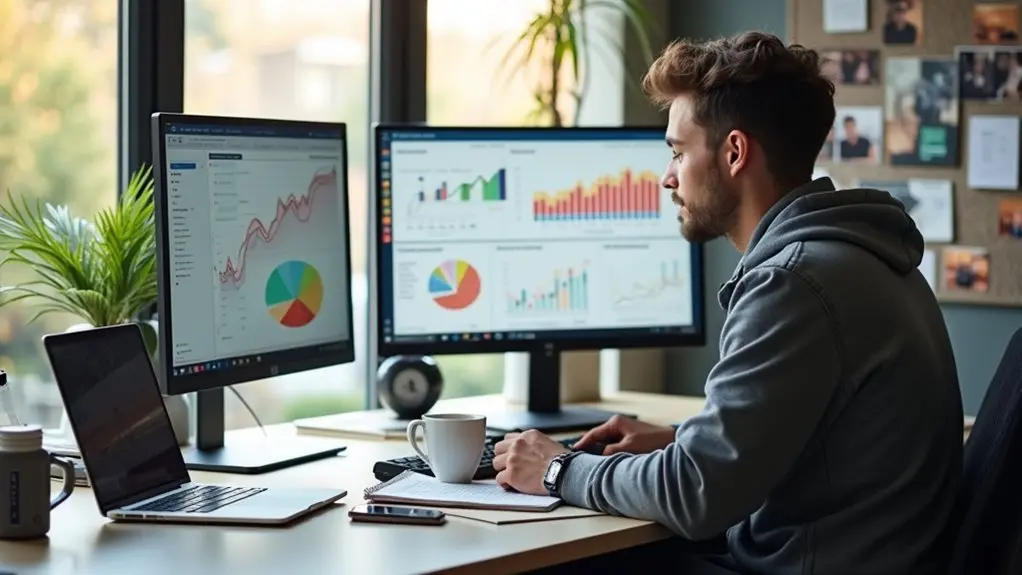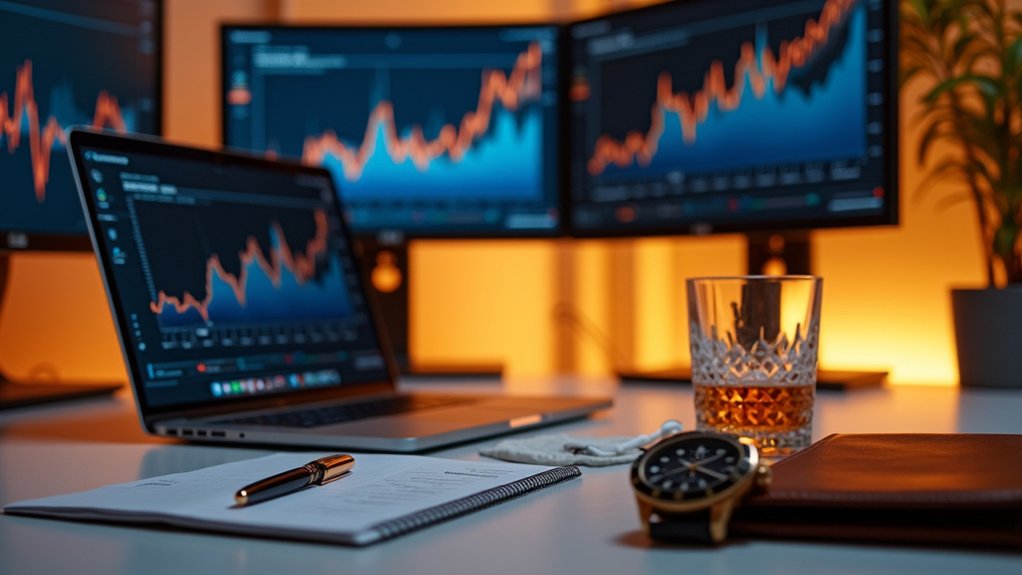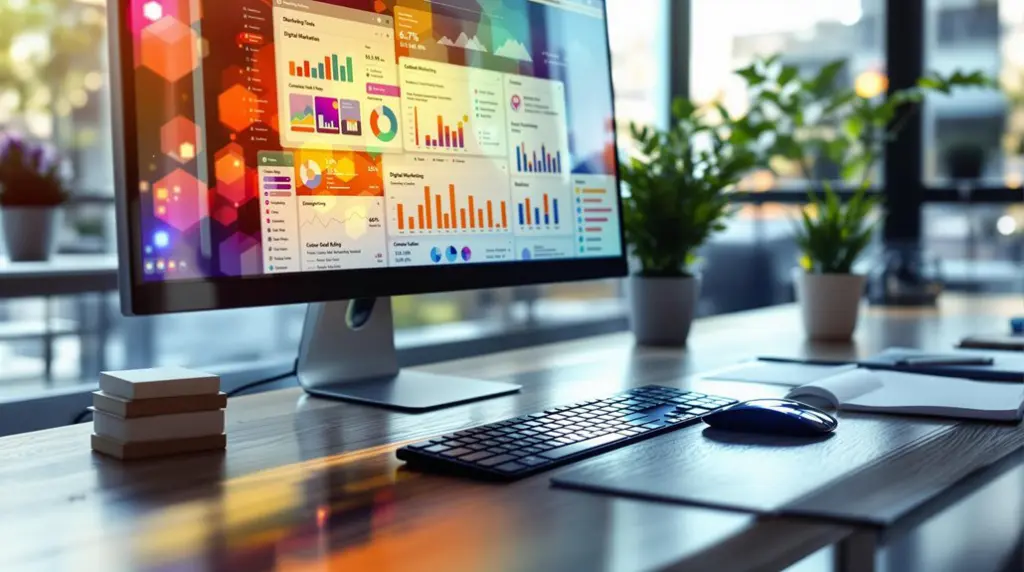Maximizing social media engagement necessitates strategic timing informed by data. The ideal posting times generally fall between 9 a.m. and 3 p.m. on weekdays, with platforms like Facebook and Instagram showing peak activity around mid-mornings and early afternoons. For Facebook, Mondays and Tuesdays are especially effective, while Instagram boasts high engagement on Wednesdays at 11 a.m. TikTok posts perform best on weekends and late afternoons. Regular analysis of engagement metrics and competitive benchmarking are critical for refining these timings. For those looking to amplify their social media strategy, exploring these data-driven insights is essential.
Key Takeaways
- Post on Facebook between 9 a.m. and noon on Mondays and Tuesdays for highest engagement.
- Optimal Instagram posting times are 11 a.m. PST on Wednesdays and mornings between 9 a.m. and 11 a.m.
- For TikTok, post at 9 a.m. on Saturdays and 4 p.m. to 6 p.m. on Tuesdays and Fridays.
- YouTube engagement peaks at 6 p.m. on Fridays and weekdays from 2 p.m. to 4 p.m.
- LinkedIn posts perform best on Tuesdays and Wednesdays from 10 a.m. to noon.
Importance of Posting Timing
Understanding the importance of posting timing is crucial for maximizing social media engagement. Effective timing strategies are critical, as social media algorithms often prioritize recent posts. Monitoring engagement metrics such as likes, comments, and shares can help refine timing strategies for better results. This makes it imperative to schedule content during peak audience activity periods to guarantee maximum visibility and interaction.
Data indicates that the best overall posting window is between 9 a.m. and noon on weekdays, particularly on Mondays, Tuesdays, and Wednesdays, when engagement rates are highest. However, these general guidelines should be adjusted based on the specific platform. For example, Facebook experiences ideal engagement at 10 a.m. on Mondays and Tuesdays, whereas Instagram sees a peak at 9 a.m. on the same days.
To fine-tune these timing strategies, continuous analysis of audience engagement metrics is essential. This helps identify unique peak times tailored to specific demographics and content types. Early engagement, occurring when the target audience is most active, considerably boosts post performance.
Consequently, leveraging data-driven insights to synchronize posting times with audience activity can lead to heightened engagement and improved social media outcomes.
Best Overall Posting Times
Best Overall Posting Times
Maximizing engagement on social media hinges on strategically timing posts to align with peak user activity periods. Data-driven analysis reveals that the best overall posting window for maximum engagement spans from 9 a.m. to noon on Monday, Tuesday, and Wednesday, with Monday and Wednesday being particularly effective.
Engagement metrics indicate that Mondays see a peak around 11 a.m. to noon, correlating with work breaks at the week's start. This timing effectively captures the attention of professionals within various audience demographics. Additionally, leveraging morning posts on weekdays can yield higher engagement due to user activity trends.
Tuesdays exhibit a broader ideal time frame, from 10 a.m. to 2 p.m. and extending slightly to 3 p.m. to 4 p.m., aligning with midweek work hours when users are likely to check their feeds intermittently. Midweek, especially Wednesdays, maintains high engagement from 9 a.m. to 3 p.m., as users seek breaks in their routines to engage with social content.
Fridays also show potential, particularly between 10 a.m. and 11 a.m., as users begin to shift their focus towards leisure activities for the upcoming weekend. Understanding these nuanced engagement patterns is critical for strategizing social media posting times to maximize reach and interaction across diverse audience demographics.
Facebook Posting Times
Analyzing Facebook engagement data reveals that posts receive the highest interaction on Mondays and Tuesdays, particularly from 9 a.m. to noon, with additional peaks during work breaks on Wednesdays and Thursdays between 9 a.m. and 3 p.m.
Furthermore, Friday mornings from 9 a.m. to 11 a.m. also demonstrate significant user activity, making it another strategic window for posting. These time slots are essential as they align with audience engagement metrics that can drive higher visibility and interaction.
Additionally, leveraging group dynamics during these periods can boost organic reach and foster more meaningful community connections.
However, Sundays generally see the lowest engagement, emphasizing the importance of timing and day in maximizing visibility and interaction on the platform.
Peak Engagement Hours
Charting the landscape of social media engagement requires a strategic approach, particularly when it comes to timing. Understanding engagement trends and audience demographics is critical for enhancing Facebook posts. Data indicates that the ideal times to post on Facebook are Mondays and Tuesdays at 10 a.m., coinciding with users' morning coffee breaks. This period aligns with higher user activity, resulting in improved visibility and interaction.
Engagement peaks are also notable during weekdays, specifically on Mondays from 9 a.m. to noon and Wednesdays from 9 a.m. to 3 p.m. These time frames capture users during shifting periods in their day, such as starting work or taking breaks, thereby increasing interaction rates.
In addition, Thursdays between 8 a.m. and 2 p.m. see significant engagement, especially during lunch hours, capitalizing on users' discretionary time.
Conversely, Sundays are generally the least effective for posting, with minimal user interaction observed. Consistently posting during these ideal windows can leverage Facebook's algorithm, which prioritizes recent content, consequently enhancing overall engagement.
Best Days Insights
Understanding the ideal days for posting on Facebook is essential for maximizing engagement and reaching your target audience effectively. Data-driven analysis reveals that Mondays and Tuesdays are prime days for engagement, particularly around 10 a.m., aligning with users' coffee breaks and morning routines. These early weekday trends capitalize on a time when users are most likely to interact with content.
Midweek presents a notable opportunity, with Wednesdays showing peak engagement at 9 a.m. and 1 p.m. This period is vital for businesses aiming to maximize their reach, as users are actively seeking content during these hours.
Similarly, Thursdays from 8 a.m. to 2 p.m. offer robust engagement opportunities, particularly during work hours when users are frequently online.
Fridays also show promising engagement, especially between 9 a.m. and 11 a.m., as users prepare for the weekend and are more inclined to check social media before concluding their workweek.
Conversely, Sundays are the least effective day for Facebook engagement, underscoring the importance of focusing efforts on midweek and Friday postings.
Strategically leveraging these weekday trends can greatly enhance engagement and optimize social media performance.
Optimal Break Times
Shifting focus from the best days to post, it is equally important to take into account the ideal break times for Facebook posting to maximize engagement.
By analyzing user habits and break duration, we can strategically target specific times to enhance post visibility and interaction.
Data suggests that engagement on Facebook spikes during work breaks, particularly around mid-day. To optimize your social media strategy, consider the following break times:
- 9 a.m. to Noon on Mondays: Posting during this time frame captures the attention of users as they begin their workweek, with peak engagement occurring at 10 a.m.
- 1 p.m. to 3 p.m. on Weekdays: Users frequently check their feeds during lunch breaks, leading to higher engagement. Posting within this window takes advantage of this user habit.
- 9 a.m. to 3 p.m. on Wednesdays: Mid-week posts benefit from consistent engagement throughout the day, making it a prime time for content dissemination.
- 9 a.m. to 11 a.m. on Fridays: With the impending weekend, users are more likely to engage with posts during this morning period as they wrap up their workweek.
Instagram Posting Times
Analyzing Instagram posting times reveals that peak engagement occurs at 11 a.m. PST on Wednesdays, with Monday and Tuesday mornings also showing high activity.
These patterns suggest that mid-morning hours and lunch breaks on weekdays are strategic windows for maximizing audience interactions.
Additionally, evaluating content type performance and continually testing various posting times can help identify unique engagement trends specific to your audience.
Utilizing Instagram Insights to regularly review engagement metrics can further refine posting strategies and guarantee continuous optimization.
Peak Posting Hours
The ideal Instagram posting times are essential for maximizing engagement and reaching target audiences effectively. Analyzing audience demographics, industry benchmarks, and seasonal trends can help in identifying peak posting hours.
To optimize content scheduling, consider these data-driven insights:
- Wednesdays at 11 a.m.: This time consistently shows the highest engagement rates. Understanding platform algorithms and engagement patterns can help capitalize on this peak period.
- Mondays at 11 a.m.: Similar to Wednesdays, this time captures notable audience attention. Post frequency during this window can enhance visibility and interaction.
- Tuesdays between 10 a.m. and 4 p.m.: Spanning a broad timeframe, this interval offers ample opportunities to engage users. Aligning visual content with user preferences during these hours can maximize impact.
- Lunch Hours (11 a.m. to 1 p.m.) on Weekdays: Users are most likely to check their feeds during lunch breaks, making this an ideal window for posting.
Time zone considerations are vital; scheduling posts when your audience is most active guarantees higher engagement.
Additionally, avoid posting on Sundays, as engagement considerably drops. Strategically planning posts around these peak hours can amplify reach and foster meaningful interactions on Instagram.
Audience Behavior Insights
Understanding audience behavior is vital for enhancing Instagram posting times and maximizing engagement. By leveraging audience segmentation strategies and behavioral trend analysis, businesses can pinpoint the most effective times to reach their target demographics.
According to the data, the ideal times to post on Instagram are 11 a.m. on Mondays and Wednesdays, with additional effective times being 10 a.m. on Tuesdays and 2 p.m. on Fridays. Engagement typically peaks in the morning, particularly between 9 a.m. and 11 a.m., suggesting that users are most active during these hours.
Mondays emerge as the most effective day for Instagram posts, while Sundays see the least engagement, highlighting the importance of weekday activity in audience behavior. Testing various posting times is essential for refining strategies, as audience behavior can vary based on specific demographics and interests.
Utilizing Instagram's analytics tools to analyze audience insights provides valuable data on when followers are most active and engaged. This data-driven approach enables businesses to tailor their posting schedules effectively, ensuring content is delivered at times that align with user activity patterns, consequently maximizing engagement and reach.
Content Type Impact
Tailoring content types to specific posting times on Instagram can greatly improve engagement outcomes. Leveraging ideal times for posting can notably amplify the effectiveness of your content strategy.
- Visual Aesthetics: Mondays and Wednesdays between 9 a.m. and 11 a.m. are prime windows for showcasing visually compelling content. This period aligns with high user activity, maximizing exposure and engagement.
- Storytelling Techniques: Posts that focus on storytelling perform best on Tuesdays from 10 a.m. to 4 p.m. During this time, users are more likely to engage with in-depth narratives as they take breaks from work.
- Audience Targeting: To refine audience targeting, consider posting around 11 a.m. on Thursdays. This slot is advantageous for reaching a broad audience as users check their feeds mid-morning.
- Brand Consistency: Fridays at 2 p.m. are effective for maintaining brand consistency. As users prepare for the weekend, they are more inclined to engage with consistent, brand-aligned content.
Understanding platform differences and integrating engagement analytics into your content strategy guarantees that each post aligns with seasonal trends and ideal engagement times.
Hashtag utilization and post frequency are critical elements that, when timed correctly, can substantially boost your Instagram presence.
TikTok Posting Times
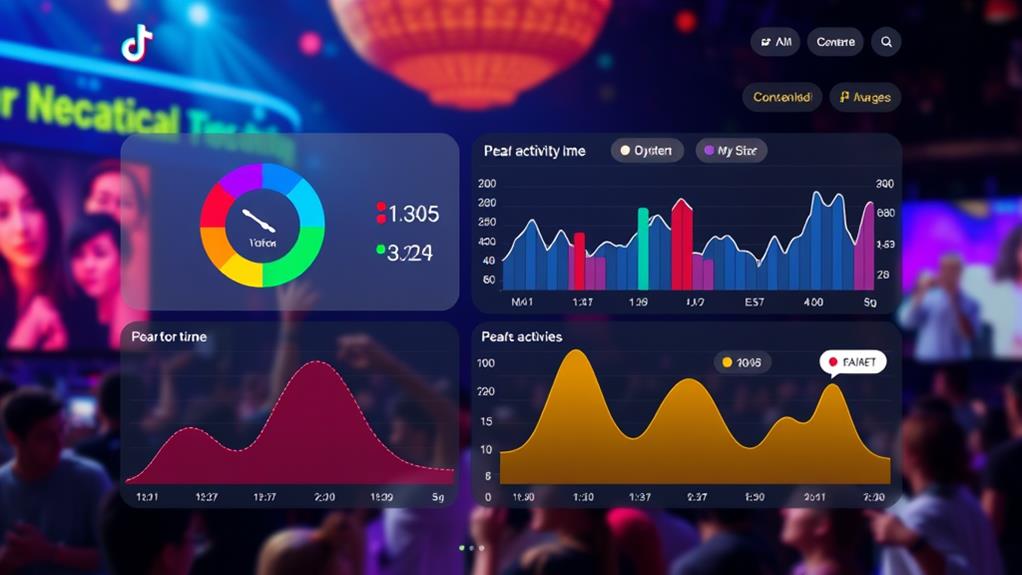
Ideal engagement on TikTok hinges on strategic timing, leveraging data-driven insights to maximize visibility and interaction. TikTok algorithms prioritize content based on timely relevance, making content timing essential. Empirical analysis reveals that posting at 9 a.m. on Saturdays garners the highest engagement. Additional peak times include Tuesday and Friday afternoons, particularly between 4 p.m. and 6 p.m. Early morning posts at 7 a.m. and 8 a.m. can also be effective.
Understanding audience demographics is fundamental. Younger demographics tend to be more active in the afternoons, aligning with identified peak times. Sundays, conversely, show the least engagement, suggesting a need to avoid this day for significant posts. Additionally, tailoring posting frequency to align with follower activity can further bolster engagement.
Here is a summary table of ideal posting times based on engagement trends:
| Day | Ideal Time |
|---|---|
| Saturday | 9 a.m. |
| Tuesday | 4 p.m. – 6 p.m. |
| Friday | 4 p.m. – 6 p.m. |
| Early Mornings | 7 a.m. – 8 a.m. |
Strategic timing experiments can refine these insights further, considering platform differences and creative strategies. Enhancing video formats and aligning with follower activity boosts TikTok's engagement potential.
YouTube Posting Times
Analyzing YouTube engagement metrics reveals that the ideal posting time is 6 p.m. on Fridays, aligning with an increase in viewers gearing up for weekend content consumption.
Utilizing real-time data can help refine this strategy further by pinpointing peak engagement hours. Engagement rates peak later in the day from Friday through Sunday, making these days particularly effective for maximizing visibility and viewer interaction.
Conversely, Mondays show lower engagement levels, highlighting the strategic importance of timing posts to align with audience behavior patterns for enhanced channel performance.
Peak Engagement Hours
When is the ideal time to post on YouTube for maximum viewer engagement? Understanding peak engagement hours can greatly enhance video consumption and viewer interaction.
Strategic content scheduling, aligned with audience demographics and engagement patterns, is essential for capitalizing on these peak times. Here's a data-driven approach to determining the best times to post on YouTube:
- Friday at 6 p.m.: This time is best as users are moving into weekend mode, making them more inclined to engage with content.
- Weekdays between 2 p.m. and 4 p.m.: Many viewers check YouTube during work breaks, offering a good window for posting.
- Avoid Mondays: Viewer habits indicate that Mondays see lower activity, making it a less effective day for posts.
- Continuous Analysis: Regular trend analysis of audience engagement metrics helps tailor posting frequency to specific channel needs, given that platform algorithms and time zone considerations may affect results.
Optimal Days Posting
Understanding the ideal days for posting on YouTube is vital for maximizing viewer engagement and driving channel growth. Data indicates that Fridays at 6 p.m. are particularly effective, leveraging increased viewer activity as the weekend approaches. This strategic timing aligns with favorable engagement patterns, as users are more inclined to consume content during these periods.
Engagement typically spikes later in the day and over weekends, suggesting that content scheduling should prioritize these windows. Posting frequency should be optimized around these peak times to harness maximum visibility.
Weekdays, particularly from 2 p.m. to 4 p.m., also show promising engagement, likely as users wind down from work. Conversely, Mondays are suboptimal, with audience demographics indicating reduced attention due to the start of the workweek.
It's essential to take into account time zone considerations, guaranteeing that content reaches a broad audience at their most active times. Seasonal trends also play a role; for instance, holiday periods might alter engagement patterns.
Consistently analyzing engagement metrics allows for fine-tuning of content scheduling to align with specific audience behaviors, thereby optimizing algorithm impacts and platform differences. This data-driven approach guarantees sustained channel growth and enhanced viewer interaction.
LinkedIn Posting Times
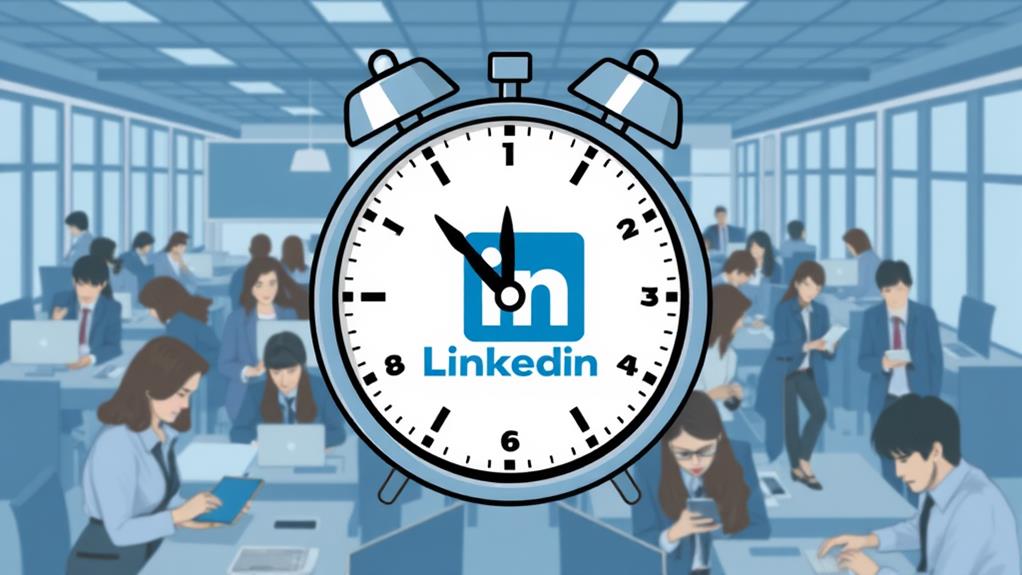
Maximizing LinkedIn engagement necessitates a strategic approach to posting times. Leveraging the right time slots can greatly enhance visibility and interaction. Analytics suggest that the ideal moments for LinkedIn engagement are during work hours, particularly from 10 a.m. to noon on Tuesdays and Wednesdays. These periods align with user activity patterns, as professionals are actively seeking relevant content.
Personalizing content based on audience targeting can further boost relevance and engagement, as 74% of users trust brands offering personalized content.
To further refine your LinkedIn strategy, consider the following data-driven insights:
- Tuesday and Wednesday Mornings: Posting between 10 a.m. and noon on these days captures audience attention when engagement peaks.
- Monday at 11 a.m.: Ideal for connecting with users as they start their work week, aligning with their content consumption habits.
- Thursday at 10 a.m.: Takes advantage of midweek productivity, ensuring your posts reach a highly engaged audience.
- Weekdays, 9 a.m. to 5 p.m.: Broadly effective for posting, as professionals are most active during these hours, seeking industry trends and valuable insights.
Understanding audience demographics and incorporating content relevancy, visual content, and a robust hashtags strategy can further enhance LinkedIn engagement.
Time zone considerations and consistent posting frequency are essential to align with global user activity patterns, ensuring maximum reach and impact.
Variability in Posting Times
Building on the insights for LinkedIn, it becomes evident that ideal posting times are not one-size-fits-all across social media platforms. Posting trends show significant variability, with peak engagement typically occurring from Tuesdays to Thursdays between 9 a.m. and 2 p.m. However, platform differences highlight the need for more nuanced strategies. For instance, while Facebook engagement peaks at 11 a.m. to noon on Mondays, Instagram sees higher interaction at 9 a.m. on Mondays and Tuesdays.
Optimal posting days and times can also vary based on industry-specific trends, making it vital to tailor content schedules accordingly. Audience segmentation further complicates content timing. User demographics and content type heavily influence the best posting hours, making it essential to tailor strategies for specific audience groups.
Continuous monitoring of engagement metrics is vital to identify unique peak times for individual accounts and industries. Leveraging tools like Sprout Social and Buffer can assist in scheduling and analyzing posts to maximize engagement.
Moreover, algorithm changes can alter engagement patterns, necessitating adaptive testing strategies. By experimenting with various posting times and formats, businesses can better align with evolving audience behaviors. As demographic shifts and platform updates occur, maintaining flexibility in posting frequency and timing becomes imperative for maximizing engagement.
Finding Optimal Times
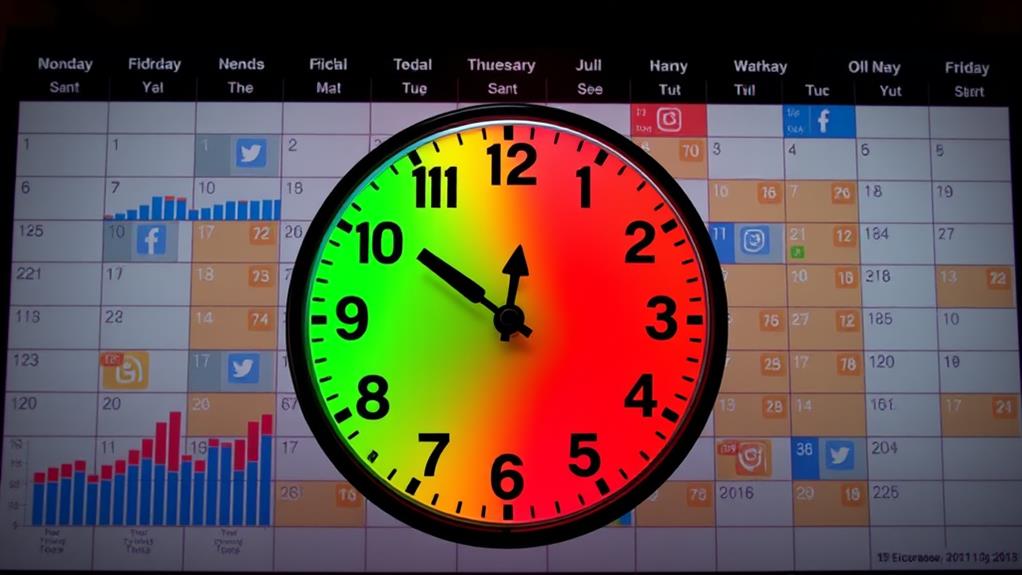
Identifying the best times to post on social media demands a data-driven approach, considering the dynamic nature of user engagement patterns. To effectively determine ideal posting times, several key factors must be analyzed:
1. Audience Demographics: Understanding the age, location, and interests of your audience is vital. Different demographics exhibit varying online behaviors; for instance, younger audiences may be more active on TikTok on weekends, while professionals might engage more on LinkedIn during weekday mornings.
Remarkably, 70% of job seekers use LinkedIn as their primary resource for job hunting, highlighting the importance of timing posts for maximum visibility.
2. Seasonal Trends: Engagement patterns can shift with seasons and holidays. For example, social media usage typically increases during holiday seasons, requiring adjustments to your content strategy to capitalize on heightened activity.
3. Platform-Specific Recommendations: Each social media platform has distinct peak times. Facebook sees the highest engagement at 10 a.m. on Mondays and Tuesdays, while Instagram peaks at 9 a.m. on the same days.
TikTok users are most active at 9 a.m. on Saturdays, and YouTube engagement is highest at 6 p.m. on Fridays.
4. Continuous Analysis and Testing: Regularly analyze audience engagement metrics and experiment with different posting times. This iterative approach helps refine your content strategy based on real-time data, ensuring that you adapt to evolving user behaviors and preferences effectively.
Audience Engagement Insights
Understanding audience engagement insights is vital for optimizing social media strategies. Analyzing engagement patterns reveals that audience demographics and platform variations greatly influence user behavior. For instance, Facebook engagement peaks at 10 a.m. on Mondays and Tuesdays, while Instagram sees heightened activity at 9 a.m. on the same days.
Conversely, TikTok users are most active on Saturdays at 9 a.m., indicating distinct engagement triggers across platforms. Tweets with hashtags see 100% more engagement, highlighting the significance of strategic hashtag use.
Time zone considerations are essential, as they guarantee content reaches audiences during their peak activity times. Seasonal trends also play a role in user behavior, with certain periods of the year witnessing shifts in engagement patterns. Remarkably, LinkedIn's audience, primarily comprising professionals, shows the highest engagement during work hours, particularly at 10 a.m. on Tuesdays and Wednesdays.
Content preferences and post frequency must align with these insights to maximize interaction. Audience segmentation allows for tailored content that resonates with specific groups, enhancing engagement.
Morning posts generally yield higher engagement across platforms, while weekends see lower interaction rates. Strategic adjustments based on these insights can greatly improve social media performance, ensuring content reaches and engages the intended audience effectively.
Competitive Analysis
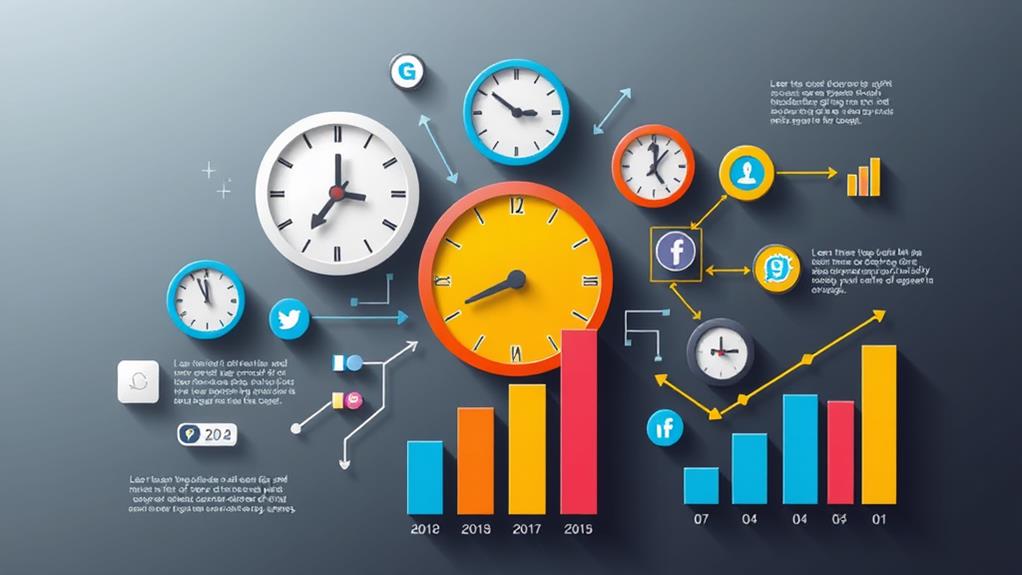
Analyzing competitors' social media strategies provides invaluable insights that can refine your own content planning and posting schedules.
By examining competitor benchmarking data, you can uncover peak engagement times and effective engagement strategies. For instance, leveraging hashtag performance can amplify brand awareness by 8%, which is a crucial consideration in your competitive analysis.
Additionally, it's beneficial to understand how visual content, which generates considerably higher engagement, is being used by competitors.
Here are four key steps to enhance your social media strategy through competitive analysis:
- Competitor Benchmarking: Use tools like Sprout Social or Buffer to compare your posting frequency and timing against industry leaders. This helps identify ideal posting windows and content types that drive higher engagement rates.
- Audience Analysis: Study the demographics and behaviors of competitors' followers to understand what resonates. This audience analysis can inform your own content optimization, ensuring alignment with preferences and behaviors.
- Trend Monitoring: Observe industry trends by monitoring high-performing posts from competitors. Identifying these trends can reveal unique opportunities or gaps in content delivery, providing strategic insights for timing adjustments and content resonance.
- Performance Metrics: Continuously analyze competitor performance metrics to fine-tune your social media strategy. Adjust your posting frequency and timing based on these insights to maintain a competitive edge and enhance overall engagement.
Data-Driven Strategies
Building on the insights gained from competitive analysis, leveraging data-driven strategies is vital in refining your social media approach. Analyzing audience engagement metrics is essential for identifying peak posting times. General best practices recommend midweek mornings, specifically between 9 a.m. to noon on Mondays and Wednesdays, for maximum visibility. However, these ideal windows can vary, necessitating a nuanced approach.
Utilizing data analytics enables precise audience segmentation, allowing for tailored content delivery that aligns with specific user behaviors on different platforms. User-based studies emphasize the importance of testing various posting times and content formats to enhance engagement. This iterative approach is necessary, as audience behavior is not static and changes across platforms and over time.
Continuous monitoring of performance metrics facilitates agile adjustments to your posting strategy. Leveraging social media management tools like Buffer can provide personalized recommendations based on historical performance data, further enhancing engagement.
Frequently Asked Questions
What Are the Peak Hours for Social Media?
Peak hours for social media, determined by analyzing social media trends and audience behavior, are 9 a.m. to noon on Mondays, Tuesdays, and Wednesdays. Specific platforms show varied ideal times, including 10 a.m. on Facebook and 6 p.m. on YouTube.
What Is the Best Time to Post on Instagram for Highest Engagement?
To achieve the highest engagement on Instagram, consider posting at 9 a.m. on Mondays, 11 a.m. on Tuesdays, and between 11 a.m. and 1 p.m. on Wednesdays. This aligns with Instagram algorithms, audience demographics, and engagement trends for ideal content strategy.
What Gets the Most Engagement on Social Media?
Engaging content featuring high-quality images or videos, user-generated material, and trending topics greatly boosts audience interaction. Additionally, posts that encourage user comments and participation see up to 50% higher engagement rates, enhancing overall social media performance.
What Day of the Week Has the Most Social Media Engagement?
When analyzing engagement trends, Wednesday emerges as the day with the most social media engagement. This midweek peak represents an ideal posting window, leveraging higher user interaction and visibility compared to other days.
Conclusion
In summary, understanding the ideal times to post on social media platforms such as Facebook, Instagram, and TikTok is essential for maximizing engagement. Employing data-driven strategies and conducting competitive analysis can greatly enhance audience interaction. By considering specific audience engagement insights and continuously refining posting schedules based on empirical data, brands can achieve higher visibility and more meaningful connections with their target demographics. Leveraging these insights guarantees a more efficient and effective social media marketing approach.


